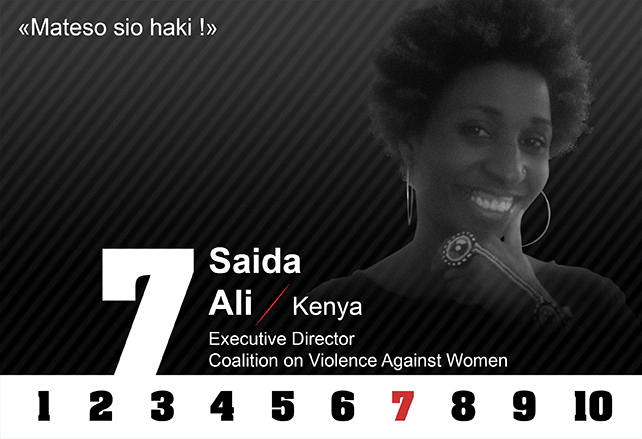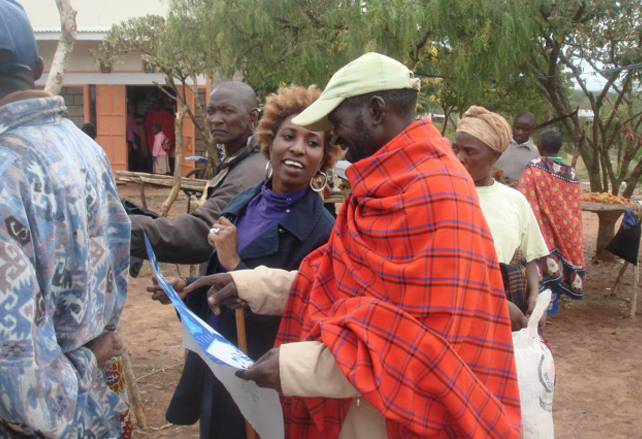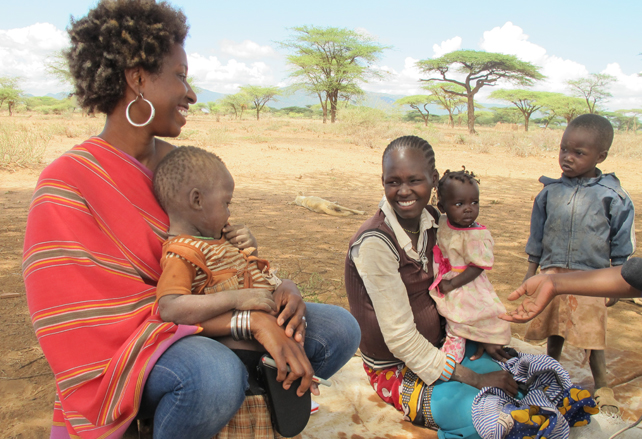Saida Ali: Ten Portraits against Torture and Impunity
- Event Date: 07.12.12
- Event Time: 00:23:00

Please, briefly introduce yourself.
I am Saida Ali. A feminist. A woman human rights defender. Currently the Executive Director of the Coalition on Violence Against Women (COVAW)-Kenya.
Today, what is the biggest challenge in the fight against torture in your country? Can you take stock of the situation of torture and ill-treatment in your country (the context, the extent of the problem, the type of victims and perpetrators, etc.)?
Specifically as regards violence against women in Kenya, we are working in a context that is informed by a rise in fundamentalisms both cultural and religious, militarization in Kenya and the Great Lakes Region, conflict situations that are triggered by political and ethnic clashes and a crises of democracy where there is little or no support for the recognition of affirmative action in order to ensure the participation of women in leadership and governance structures. Women’s multiple identities also mean that they experience multiple forms of discrimination – a situation that is also informed by the interplay of the contexts. Patriarchy is the biggest challenge in the fight against torture that is of gender nature and other gender crimes.
In Kenya, the policy and legal framework provides a conducive environment for responding to violence against women. In the last seven years there has been tremendous improvement in the legal framework thereby providing women with better safeguards and justice.
Besides the Sexual Offences Act 2006 and its implementing rules, the Constitution provides an anchorage for dealing with underlying causes of violence and addressing incidences of violence. However, the challenge of reporting cases followed by successful prosecution remains a major impediment especially when it occurs in private spaces.
The availability of reliable data also remains a challenge. The data provided by the Kenya Police is not sex-disaggregated thereby it is not possible to establish out of the reported assault and bodily harm, how many cases refer to violence against women. In addition, it is not possible to establish if the reported cases of murder and manslaughter refer to women killed as result of domestic violence.

In the absence of sex-disaggregated data we can refer to other available sources of information such as the Demographic Health Survey (DHS) and any other official and non-official sources. The DHS survey for 2008 reports that 39% of married women, divorced or separated women aged 15-49 years reported to have been physically or sexually violated by their husbands or partners during their lifetime compared to 44% in 2003. About 32% reported having been violated in the last one year before the survey compared with 29% in 2003. Rural women are more likely to be victims of physical and sexual violence.
Some of key findings from the DHS survey include:
- The most prevalent form of violence is spousal violence. The survey established that more than half of the women (53%) agree with at least one of the specified reason for a husband beating his wife.
- Women accept wife beating and feel it is justified if women neglect their household duties. 13% -42% of women indicated this. Younger women and older women are more likely than women age 25-44 to accept wife beating.
- Spousal violence increases with the age of a women and the number of living children she has.
- In relation to sexual violence, 12% of women aged 15-49 reported that their first sexual intercourse was forced against their will.
- One in five women (21%) has experienced sexual violence. The results of the survey illustrate that women with secondary or higher education and those in the top wealth social groups are less likely to experience sexual violence than their counterparts.
- Gender based violence is not restricted to physical violence. Verbal abuse, restrictions on movement and withholding funds and support constitute violent behaviour.
- The Kenya Police annual crime reports indicate a steady increase in reported cases of rape and attempted rape.
According to the 2006 Sessional paper n°2 on Gender Equality and Development, sexual violence, rape, physical violence, sexual harassment and defilement cases continue to rise, compounded by clashes, land skirmishes and the rise of insecurity in the country.
The key hindrances to women accessing justice include:
- Low levels of women’s empowerment and knowledge about their rights. Women are not socialized to complain about the violations they face and encounter in their families and communities.
- Strong patriarchal culture and practises within society and communities. This manifests in public institutions such as law enforcement agencies and the judiciary.
- Lack of trust in the justice system, which is deemed to have protracted processes.
- Lack of State commitment for addressing violence against women as a public security and public health issue.
According to your experience, what are the root causes of torture and impunity ?
Torture and impunity are shaped by patriarchy especially as relates to matters of violence against women.
What is your approach and what kind of activities do you carry out to fight against torture and ill-treatment in your country? Can you give us examples of achievements linked to these activities?
The Coalition on Violence Against Women (COVAW) works towards ensuring a society that is free from all forms of violence against women. This work includes working with community based groups and organizations so as to build and strengthen their capacities to address violence against women at the community level and contribute towards building social movements of change agents opposed to and committed to eradicating violence against women. One of the main approaches used by COVAW (K) is to use power analysis to engage communities in reflections that make them realize that women are violated due to unequal power dynamics and other gender inequalities. COVAW (K) provides training and support to community activists in order to sustain the work at the community level.
COVAW (K) also trains health workers, law enforcement agents and paralegals and has a network of activists and service providers drawn from different parts of the country.
By the end of 2012, COVAW (K) will have trained over 1500 health workers, 300 law enforcement agents, 120 community activists and 200 paralegals. This translates to an outreach of 4,700 households, 15,000 women and 9,400 men per year. Through this work, COVAW (K) has developed a strong network of women leaders and champions who are committed to eradicating violence against women, and the recognition of various forms of violence as torture.
COVAW (K) recognizes that culture plays a huge role in oppression of women and as such works with custodians of culture to address negative cultural practices such as female genital mutilation (FGM), and beading of girls that are both human rights violations and forms of torture. COVAW (K) has trained and works with 100 custodians of culture most of whom are male elders in their communities.
COVAW (K) also uses law through strategies such as court representation, integration of law and health, and the instituting public interest litigation to seek redress for victims / survivors of sexual and gender based violence. One of the big cases that COVAW (K) and others are currently instituting is one that seeks compensation and redress for victims of sexual and gender based violence during the 2007/08 post election violence in Kenya.

What obstacles do you encounter daily when carrying out your activities?
Patriarchy poses the greatest obstacle to the work on defending women’s rights, specifically in addressing violence against women. Patriarchy and heteronormative ideologies shape the multiple identities of women. The socially constructed privileging of male experiences/ power in all forms of social relations is a daily obstacle as any intervention that questions that status quo is always met with an obstruction of one kind or the other – be it in access to justice or speaking out against such warped power dynamics.
Gender discrimination and inequality are perpetuated through social structures and institutions, cultural and religious beliefs and norms, laws, policies and other forms of public discourses that justify violations of women’s rights. All of these are shaped by both patriarchy and heteronormativity.
Do you feel threatened because of your activities? Do you face any interference in your work? If this is the case, can you kindly precise.
Not always but sometimes this happens. There are times there is interference by abusive men whose partners have sought assistance from our office, state agents who refuse to cooperate or take actions, state agents who deliberate on alternative dispute resolution on criminal cases such as rape, some anonymous threats from people who think that it is against their culture that we question practices that are oppressive to women and girls, and open verbal insults from those that are threatened by the empowerment of women and questioning the status quo.
What needs to be done so that « Nothing justifies torture » becomes a reality in your country?
There needs to be effective gender sensitive responses to addressing torture and ensure the protection of women and girls since at times acts of violence against women are not necessarily seen to be forms of torture. Work on « Nothing justifies torture » needs to adopt a movement building so that there is alliance building within countries and across borders.
That way the message that nothing justifies torture will reach millions of people and especially in regards to violence against women there will be national and international solidarity and advocacy efforts. From an accountability point of view, it is important for States to create mechanisms for protection of women/ girls, ensure prevention of violence, prosecute and punish offenders, and provide support systems for victims/ survivors of violence.
It is important to highlight the situation of women human rights defenders, as this is an area that has received little attention in the human rights arena. This focus will be the beginning of transcending gender barriers that women human rights defenders encounter.
What part plays and should play the public opinion in the fight against torture and what can the public do to support the fight against torture?
Public opinion is important in changing mindsets and attitudes of all people including duty bearers so that they ensure no excuses are given when acts of violence against women are committed. It helps to shape action as relates to holding others to account, upholding women’s rights as human rights and ensuring mechanisms to address sexual and gender based violence as various forms of torture.
The public needs to speak up and speak out to condemn all forms of violence against women as silence is a sign that the public condones and accepts torture as a way of life.